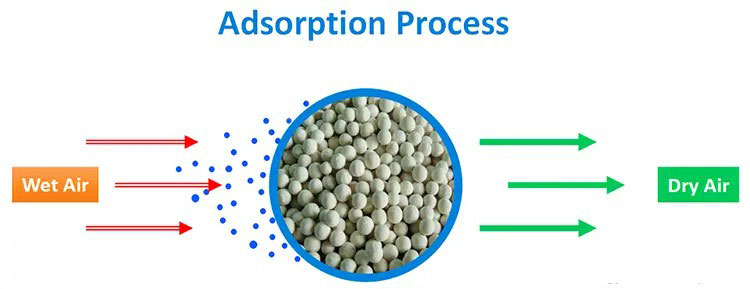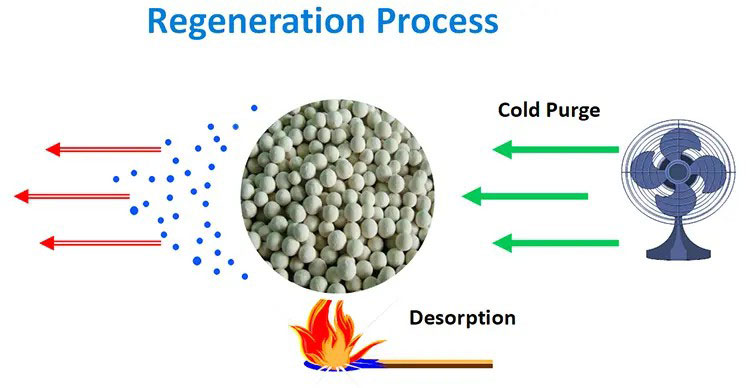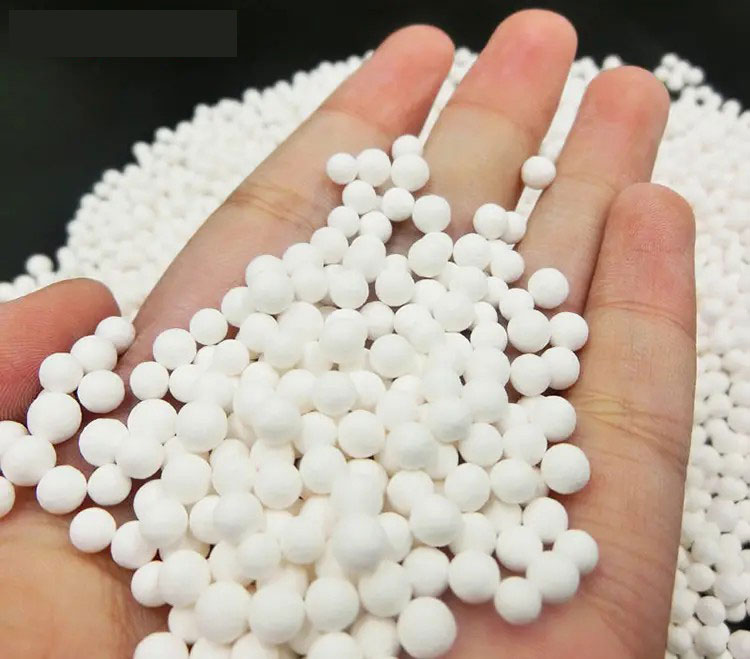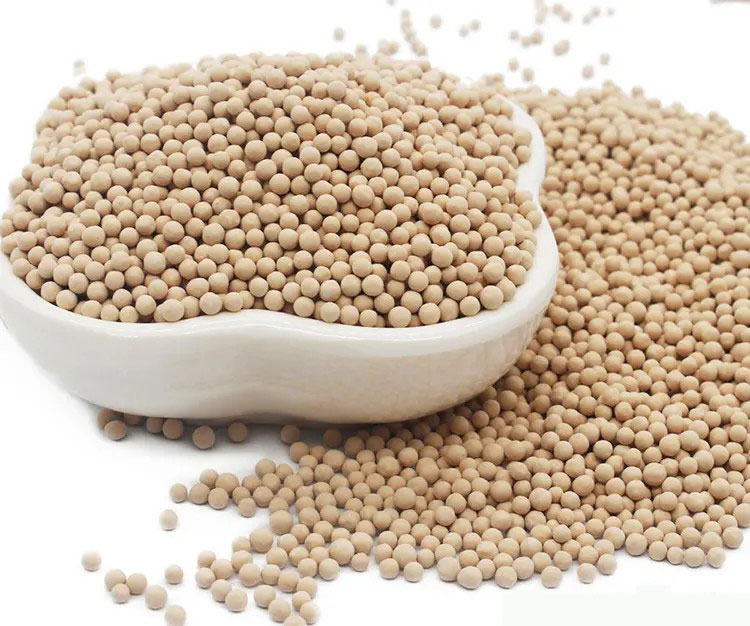Product news
How to choose desiccant air dryer beads for air compressor?
Writer: admin Time:2022-10-12 00:00:00 Browse:746℃
Adsorption air dryer is an important compressed air purification equipment. The main function material of desiccant air dryer is drying beads. The common adsorbents in regenerative dryer are as follows. That is, activated alumina, molecular sieve, silica gel, etc. Among them, the former two kinds are more popular. They can effectively absorb moisture from the air.
1. What’s the function of desiccant dryer beads?
This is how the desiccant air dryer works. We use drying beads to absorb water vapor in compressed air. So get dry air with a certain dew point. At the same time, let the adsorbents regeneration. Let’s take the heated desiccant air dryer as an example. So as to explain the working principle of adsorption dryer.

Firstly, moist hot air passes through the adsorbent in the dryer. Then the drying beads will absorb the water vapor in it. Because there is more water in the air than the surface of the adsorbent. So the surface capillaries can hold these moisture. So this is the adsorption process of desiccant beads.

The heat regenerative dryer has an external heater. Heating helps water vapor overcome Van Der Waals forces. Thereby, the moisture will release from the desiccant beads. In addition, this dryer also uses a small amount of regeneration air. The primary function of the regeneration air is to “purge”. That is, it will be purge the water from the adsorbent. Finally carry them away from the drying beads surface.
In summary, the adsorbent is the main material for the dryer to remove water.
2. Activated alumina – the first desiccant beads for air compressor
Activated alumina is also known as activated bauxite. It is a porous solid material. There is a large surface area. Its microporous surface has the properties for catalysis, such as adsorption performance, surface activity, excellent thermal stability, etc. Therefore, it is widely used as a catalyst for chemical reactions.
Alumina has selective adsorption capacity for gas, water vapor and moisture. After the adsorption is saturated, it can remove water under heating. Adsorption and desorption can be performed multiple times. Therefore, it often acts as the desiccant beads. In the adsorption air dryer, the common specification is 3~5mm. The dew point of activated alumina pressure swing adsorption in the air separation industry can reach -55℃.
| Name | Activatedaluminadesiccant |
| Crystalphase | x-ρAl2O3 |
| Specification(mm) | Φ3-5 |
| Appearance | whitespherical |
| Bulkdensity(g/cm3) | 0.7~0.76 |
| Intensity(N/granule) | >140 |
| Specificsurface(m2/g) | 300~320 |
| Porevolume(cm3/g) | 0.38-0.40 |
| Staticadsorptioncapacity(RH%) | 18 |
| Wearrate%≤ | 0.3 |

3. Molecular sieve – the second desiccant dryer beads
Molecular sieves have uniform pores. Its pore size is comparable to the general molecular size. It has wide applications. It can be used as high efficiency desiccant beads, selective adsorbent, catalyst, ion exchanger, etc. Compared with other adsorbents, its biggest feature is the microporous structure with uniform diameter. Therefore, it can selectively adsorb gaseous molecules with diameters smaller than their pore diameters .
Molecular sieves are generally synthetic. Its thermal and chemical stability is high. It also has other good properties, such as sieving, ion exchange, selective singleness and adsorption performance. So it has wide application in desiccant air dryer. There are generally two types of molecular sieves used in adsorption air dryer. That is, 4A and 13X molecular sieve.
(1) 4A molecular sieve
The pore size of 4A molecular sieve is 4A. It can adsorb water, methanol, ethanol, carbon dioxide, etc. Of course, it doesn’t adsorb any molecules larger than 4A in diameter. The selective adsorption of water is higher than that of any other molecule. It is one of the most widely used molecular sieves.
Chemical formula: Na2O·Al2O3·2SiO2·9/2H2O
Si-Al ratio: SiO2/Al2O3≈2
Effective pore size: About 4Å
4A molecular sieve parameters:
| Index | Unit | Spherical |
| Specification | mm | 3~5 |
| Staticwateradsorption(25℃,RH50%) | %wt | ≥21.5 |
| Wearrate | %wt | ≤0.2 |
| Bulkdensity | g/ml | 0.69-0.75 |

(2) 13X molecular sieve
13X molecular sieve is also known as sodium X molecular sieve. It has a certain alkalinity. Its pore diameter is 10A. So adsorbs any molecule greater than 3.64A and less than 10A. We mainly use it for the drying of medicine and compressed air system. Chemical formula: Na2O·A12O3·2.45SiO2·6.0H20. And pore size: 10A.
| Index | Unit | Spherical |
| Specification | mm | 3~5 |
| Staticwateradsorption(25℃,RH50%) | %wt | ≥25 |
| Wearrate | %wt | ≤0.2 |
| Bulkdensity | g/ml | >0.6 |
4. Silica gel – the third desiccant drying beads
It is a transparent or milky white granular solid. The chemical formula is xSiO2 yH2O. It has a porous structure. So the adsorption performance is strong. Silica gel can adsorb a variety of substances. For example, some silica gels absorb about 40% or even 300% of moisture. It has wide use in gas drying & absorption, liquid dehydration, chromatography, etc. Also acts as a catalyst. It’s recyclable for repeated use.

5. How to choose the desiccant dryer beads?
We must consider various factors in the selection of air dryer beads. For example, we have to consider dew point, type of desiccant dryer, cost, etc. In addition, it is also related to the dryness of the regeneration air and the heating temperature.
(1) Dew point requirements of desiccant air dryer
The desiccant air dryer usually uses 4A molecular sieve and 3~5mm alumina. So what is the difference between them in performance? Why divide molecular sieve or alumina? Below we list their differences in key indicators:

In summary, the only advantage of molecular sieves is that they have very strong water absorption properties. But neither the strength nor the wear rate is as good as alumina. That is, the service life of the alumina is long. But molecular sieves have a short lifespan.
Alumina can theoretically reach a pressure dew point of -50℃. In fact, it can fully guarantee -40℃. The molecular sieve can reach a pressure dew point of -70. In terms of drying performance, molecular sieves are much better than alumina. But its replacement cost is higher. Besides, the lifetime is not as good as activated alumina.
Therefore, we must be sure to understand the user’s requirements or expectations for dew point before choosing air dryer beads. So choose the best solution. It can not only meet the performance requirements of users, but also reduce the cost of use.
For -20℃ dew point desiccant air dryer, it’s usually enough to use the activated alumina. And for -40℃ dew point dryer, we usually use both activated alumina and molecular sieves. For deep drying, usually use the alumina for pre-drying first. Then use molecular sieves to remove residual water vapor.
Other key indicators of air compressor dryer beads:
The adsorbent will bear a certain pressure in the adsorption tower of the air dryer. Therefore, our air dryer beads need to achieve a certain compressive strength. Also need to consider the wear rate. If the wear rate is high, it is easy to generate excessive dust. If the back-end filtration is not good, it will also affect the quality of compressed air. The last is the bulk density. It refers to the weight of the adsorbent per unit volume. This affects the loading of desiccant drying beads. That is, it will affect the production cost of adsorption air dryer.
Although silica gel has a strong ability to absorb water, it is easily crushed. Especially when there is work pressure. That is, the lifetime is not long. Therefore, silica gel is not commonly used as an adsorbent in desiccant dryers.
(2) Regeneration of desiccant dryer beads
Different adsorbents have different temperature requirements when regenerating. When the regeneration temperature does not meet the requirements or the regeneration time is insufficient, the regeneration of desiccant beads will be incomplete. This affects the adsorption performance of the adsorbent. Finally it will affects the dew point of compressed air.
If not full regeneration for a long time, liquid water will accumulate over time. Once the contact time is long, it will reduce the compressive strength of the adsorbent. It is easy to cause the powder of air dryer beads. Thus, it will affect the operating environment of the air after-treatment system. It also directly increases the maintenance cost of the enterprise. Therefore, we need to set a reasonable regeneration temperature and regeneration time according to the different characteristics of desiccant drying beads.
Generally, the regeneration temperature of activated alumina is in the range of 160℃~190℃. That of molecular sieve is between 200℃-250℃. In addition, the regeneration temperature of silica alumina gel is between 120°C and 150°C.
(3) Energy consumption requirements of desiccant air dryers
The regeneration energy consumption is also affected by the regeneration cycle. Under the same dew point condition, the smaller the filling amount, the smaller the regeneration air consumption. That is, the better the adsorption performance of desiccant beads, the smaller the regeneration energy consumption.
Take the normal micro heated desiccant dryer as an example. The filling capacity of the twin towers is within 1 ton. If use conventional activated alumina , it will take about 1.5 hours to adsorb. Cost 1 hour for heating and 30 minutes for cold purging. And if use high efficiency activated alumina, the entire working cycle can be to 2 hours. This can also play a role in reducing consumption. Because the adsorption rate of high-efficiency alumina is much higher.
If the requirement for dew point is higher, it can add some molecular sieve. Reduce the filling amount of adsorbent, so as to save electricity and air.
6. Mixing and filling sequence of drying beads in desiccant dryer
When a single adsorbent does not meet the requirements, it is recommended to mix them. At this time, you need to pay attention to the order of filling. Because their adsorption properties and compressive strength are different. Activated alumina has higher compressive strength. Therefore, in the position of the air inlet with strong air pressure, it’s better to choose activated alumina. This can avoid strong airflow impact. It can also prevent the crushing of desiccant beads pellets. And we usually fill the molecular sieves in the middle of the towers.
CATEGORIES
LATEST NEWS
- Air compressor with oil-removal purifier for laser cutting machine
- How Does Refrigerated Compressed Air Dryer Work? Brief Guide
- Zero Air-loss HOC Heat of Compression Dryer Energy Consumption Analysis
- Six Air Compressor Calculation Formulas ~ Examples Demonstration
- What to Look for in Screw Compressor with Dryer | Expert Guide
CONTACT US
QQ: 89080830
Phone: +86-18080420046
Tel: +86-28-84369018
Email: 89080830
Add: Room 1010, Building 5,No.199,Road Huaishudianlu,City Chengdu,China